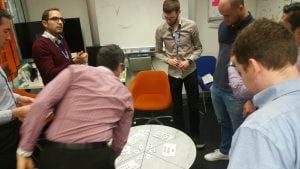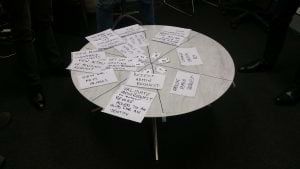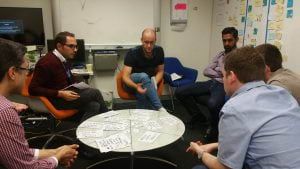"eXtreme Quotation": Agile Planning on steroids
OCTO Technology has been using this methodology for quite some time both in France and in Australia. The following is the story of the 1st time we applied it.
As a team, we estimated about 90 user stories in 20 minutes. Basically, the whole story map.
We supposed that this technique would make things quicker and less painful and it really turned out that way
Since then, this experience has been run in France and Australia with several teams and we obtained similar results.
Let’s detail how we run this Agile planning to help you understand why it works so well.
Extreme Quotation : agile planning “cards on desk”
| Duration | 1h max. But plan to wrap it up in less time |
| Participants | - Developers, product owner, business analysts<br>- Product manager<br>- Agile facilitator |
| Equipment | - A room<br>- 2 tables<br>- User stories from the Story Map printed on post-it or cards<br>- Planning poker cards<br>- Colourful scotch (chatterton for instance) |
We will illustrate some of these steps with pictures we took when we ran the agile planning in a project in Sydney.
If you have to animate here are the different steps :
Prepare the room
- Put one table in the centre without chairs; you want the members of the team to be able to walk without getting in each other’s way. This table will be the Evaluation table.
- Use the scotch to split the table in 6 or 7 columns (or pie slices, depending on the table’s shape). On top of the columns put the planning poker cards in increasing order (Fibonnacci until 100 and the “?” card).
- Place one or two calibrating user stories on the table that the team has chosen beforehand.
- Put the second table close to the Evaluation table. But not close to the point it is getting in members way to move freely. This is the User story table.
- Put all the user stories to estimate on this table.
Start
To introduce the principle of this agile planning to your team you can start like this:
«Here is the program/activity/workshop of the day: place the user stories in the corresponding columns based on their complexity to fully test them. Basically, if I give you the application and assure you that the feature works, how many tests do you need to verify the feature and how complex they are?
Here are some pieces of advice :
- evaluate relatively and move the stories by comparing them;
- first put down the stories as you feel them; Start by categorizing, you will move them again after, we want a quick answer first of all. Even if you think the answer is wrong; we will improve on it iteratively in the next step;
- if you have any doubts, move the story to the upper column;
- if you don’t know how to evaluate a user story put it on the “?” column;
- the product manager and the product owner don’t estimate but they are here to answer your questions. For those who have business knowledge, be open and encourage the team members to question your choices;
- let’s roll!
»
Sort user stories for a first time
Stay in the back as a facilitator and do not give specific instructions. The group understands that everybody is moving the stories in the meantime.
- Let the team work.
- Answer to team’s questions, repeat instructions if it is necessary but try not to participate to the debate as much as you can.
- If it is taking time, encourage the team to place the cards the as quickly as possible : “We want to have as many estimations as possible in the least amount of time we can”.
- Observe how the group behaves.
This phase should take around 10 minutes.

Shake the result
Once the user stories are placed and nobody is moving them anymore, ask questions to the team to make everybody think a bit more. Do not ask several questions at a time, only one at a time and observe if this causes adjustments. In case it happens, wait until it stops again.
Example of questions you can ask :
- Did everybody look at all user stories ?
- Do you think there still are some stories that are placed at least two columns from where they should be ?
- Do you think the stories’ estimations are consistent between each others ?
- Have you understood all the user stories ?
- Do you think we have finished ?
- Do you think we can start the next iteration based on these estimations ?
etc
The aim of these questions is to question the reasoning and make the estimations increase; ask questions until the user stories don’t move from one column to another. When the team members don’t move the post-its / cards it means they are reasonably happy about the estimations, it’s over.
Before shaking :

Discussion about the stories where there doubts :

Clean up
It is not over yet. Ask the team to write down on each user stories card the number of the column where it is placed. Then put everything back where it is supposed to be : tables, chairs, throw away chatterton, etc etc.
Experience return
If you have tried this style of agile planning, we are interested in your experiences. Feel free to drop us a comment or to ask us anything about this method.